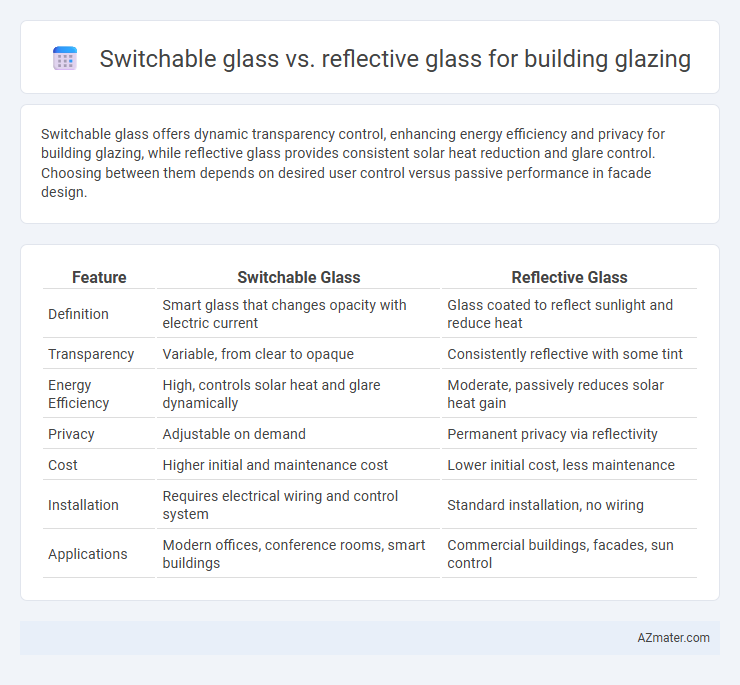Switchable glass offers dynamic transparency control, enhancing energy efficiency and privacy for building glazing, while reflective glass provides consistent solar heat reduction and glare control. Choosing between them depends on desired user control versus passive performance in facade design.
Table of Comparison
| Feature | Switchable Glass | Reflective Glass |
|---|---|---|
| Definition | Smart glass that changes opacity with electric current | Glass coated to reflect sunlight and reduce heat |
| Transparency | Variable, from clear to opaque | Consistently reflective with some tint |
| Energy Efficiency | High, controls solar heat and glare dynamically | Moderate, passively reduces solar heat gain |
| Privacy | Adjustable on demand | Permanent privacy via reflectivity |
| Cost | Higher initial and maintenance cost | Lower initial cost, less maintenance |
| Installation | Requires electrical wiring and control system | Standard installation, no wiring |
| Applications | Modern offices, conference rooms, smart buildings | Commercial buildings, facades, sun control |
Introduction to Building Glazing Technologies
Switchable glass offers dynamic control over light transmission and privacy by changing its opacity through electrical activation, making it ideal for energy-efficient building glazing. Reflective glass reduces solar heat gain and glare by incorporating a metallic coating that reflects a portion of sunlight, enhancing thermal insulation and occupant comfort. Both technologies contribute to sustainable architecture by improving indoor environmental quality and reducing energy consumption in commercial and residential buildings.
What is Switchable Glass?
Switchable glass, also known as smart glass or privacy glass, changes its light transmission properties when an electric current is applied, allowing it to switch from transparent to opaque instantly. This technology enhances building energy efficiency, privacy, and natural light control by reducing the need for blinds or curtains. Compared to reflective glass, which relies on coatings to reflect sunlight and reduce glare, switchable glass offers dynamic adaptability, making it ideal for modern architectural glazing solutions.
What is Reflective Glass?
Reflective glass is a type of building glazing coated with a thin metallic layer that reduces solar heat gain and glare by reflecting a significant portion of sunlight away from the building. It enhances energy efficiency by minimizing cooling loads while providing privacy during daylight hours without compromising natural light. Compared to switchable glass, reflective glass maintains a constant reflective property, making it ideal for facades requiring consistent solar control and aesthetic uniformity.
Key Differences Between Switchable and Reflective Glass
Switchable glass utilizes electrochromic technology to change transparency levels, providing dynamic control over light and heat transmission, whereas reflective glass relies on a metallic coating to reflect sunlight, reducing glare and heat without altering transparency. Switchable glass offers energy savings through variable shading and privacy on demand, while reflective glass provides constant solar control and enhanced exterior mirror-like aesthetics. The choice between the two hinges on the need for adaptability in light management versus fixed solar reflection properties in building glazing applications.
Energy Efficiency Comparison
Switchable glass enhances energy efficiency by dynamically controlling heat and light transmission, reducing the need for artificial lighting and air conditioning. Reflective glass offers consistent solar heat gain reduction by reflecting sunlight, but may cause increased indoor glare and less natural light. In terms of energy savings, switchable glass provides superior adaptability to changing environmental conditions, optimizing HVAC usage more effectively than traditional reflective glass.
Privacy and Light Control Features
Switchable glass offers dynamic privacy control by transitioning from transparent to opaque states instantly, allowing occupants to manage visibility without compromising natural light. Reflective glass provides consistent privacy by reflecting external surroundings, effectively reducing glare and heat while limiting visibility from outside during daylight hours. Both options enhance building energy efficiency, but switchable glass delivers superior flexibility for privacy and light modulation based on real-time needs.
Aesthetic and Design Flexibility
Switchable glass offers dynamic control over transparency, enabling architects to create sleek, modern facades that adapt to changing light conditions and privacy needs, enhancing aesthetic appeal and design versatility. Reflective glass provides a consistent mirrored surface that reduces solar heat gain and glare while contributing a high-tech, polished look, but limits variability in appearance. Both options enhance building glazing aesthetics, with switchable glass allowing greater customization and interactive design possibilities compared to the static, uniform finish of reflective glass.
Installation and Maintenance Considerations
Switchable glass requires integration with a specialized electrical system during installation, involving wiring for power control, which can increase initial complexity compared to reflective glass that installs like conventional glazing without electrical components. Maintenance of switchable glass includes periodic inspection of electrical connections and control units to ensure consistent transparency functionality, whereas reflective glass demands less maintenance, focusing mostly on cleaning and surface preservation to maintain reflectivity. Proper installation of switchable glass is crucial to avoid electrical faults, while reflective glass installation emphasizes correct positioning and sealing to optimize energy efficiency and durability.
Cost Analysis: Switchable vs Reflective Glass
Switchable glass typically costs between $50 and $100 per square foot, driven by its advanced technology and electrical components, whereas reflective glass averages around $20 to $40 per square foot, making it a more budget-friendly option for large-scale projects. Installation of switchable glass requires specialized wiring and control systems, increasing overall expenses compared to the simpler installation of reflective glass. Long-term energy savings and maintenance costs also differ, with switchable glass offering dynamic light control that can reduce HVAC expenses more effectively than the static solar heat rejection of reflective glass.
Choosing the Right Glazing Solution for Your Building
Switchable glass offers dynamic control over light and privacy by adjusting transparency with an electrical signal, enhancing energy efficiency and occupant comfort. Reflective glass reduces solar heat gain and glare through a mirrored surface, providing passive solar control and improved exterior aesthetics. Selecting the right glazing solution depends on project-specific factors such as desired energy performance, privacy needs, daylight management, and budget constraints.

Infographic: Switchable glass vs Reflective glass for Building glazing
 azmater.com
azmater.com